Corporate Finance Assignment: Multiple Choice, Short Answer, Analysis
VerifiedAdded on 2023/04/26
|14
|2739
|423
Homework Assignment
AI Summary
This document presents a comprehensive solution to a corporate finance assignment, covering a wide range of topics. The assignment is divided into three parts: multiple-choice questions testing fundamental concepts, short-answer questions exploring theories like the pecking order theory and the differences between spin-offs and carve-outs, and analytical questions requiring calculations and explanations related to mergers, tax shields, stock repurchases, and right issues. The solution provides detailed answers to each question, including explanations of the correct choices in the multiple-choice section and step-by-step calculations for the analytical problems. The document covers key aspects of corporate finance, such as merger motives, agency problems, dividend payment procedures, and capital structure decisions, providing a valuable resource for students studying this subject.
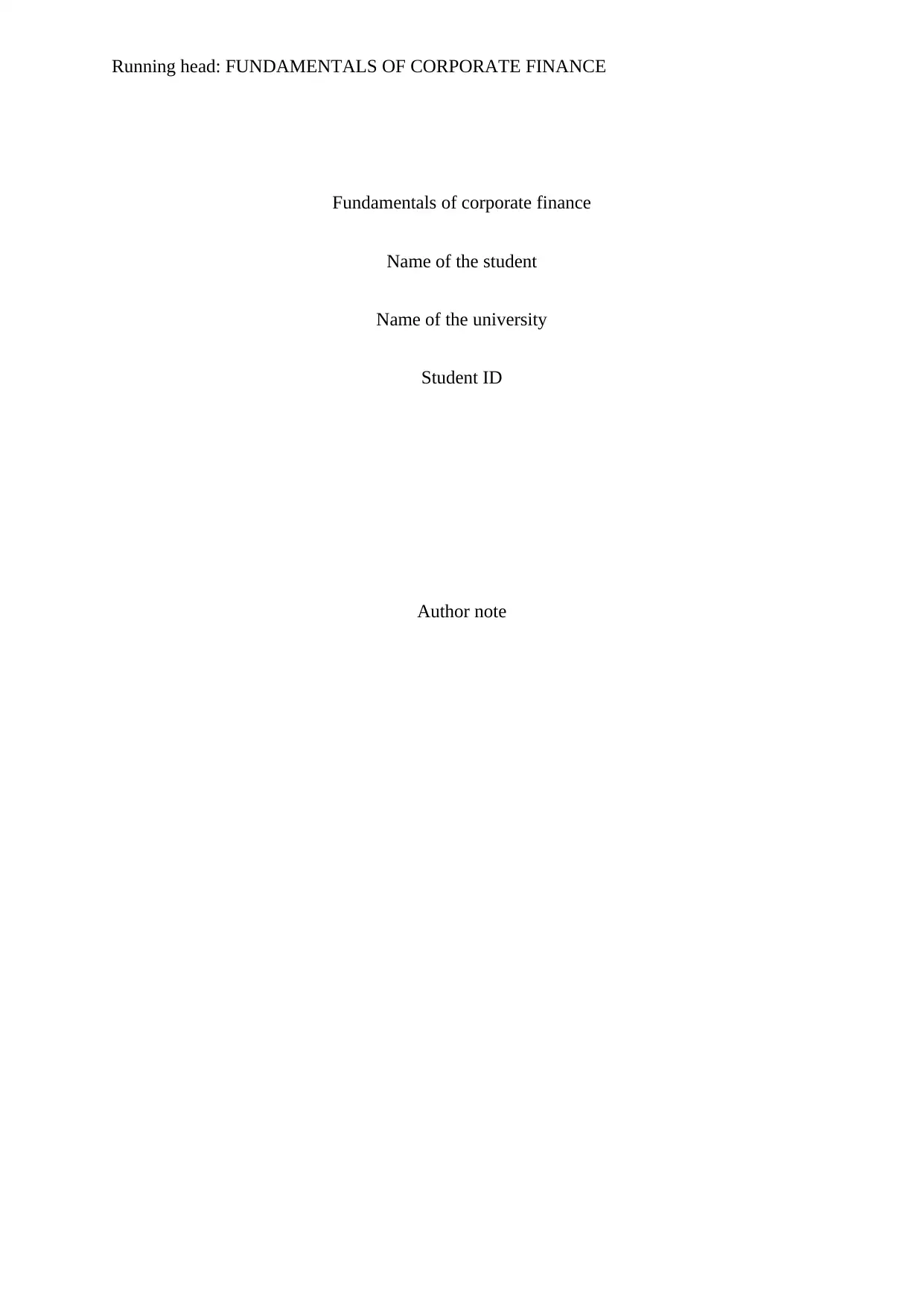
Running head: FUNDAMENTALS OF CORPORATE FINANCE
Fundamentals of corporate finance
Name of the student
Name of the university
Student ID
Author note
Fundamentals of corporate finance
Name of the student
Name of the university
Student ID
Author note
Paraphrase This Document
Need a fresh take? Get an instant paraphrase of this document with our AI Paraphraser
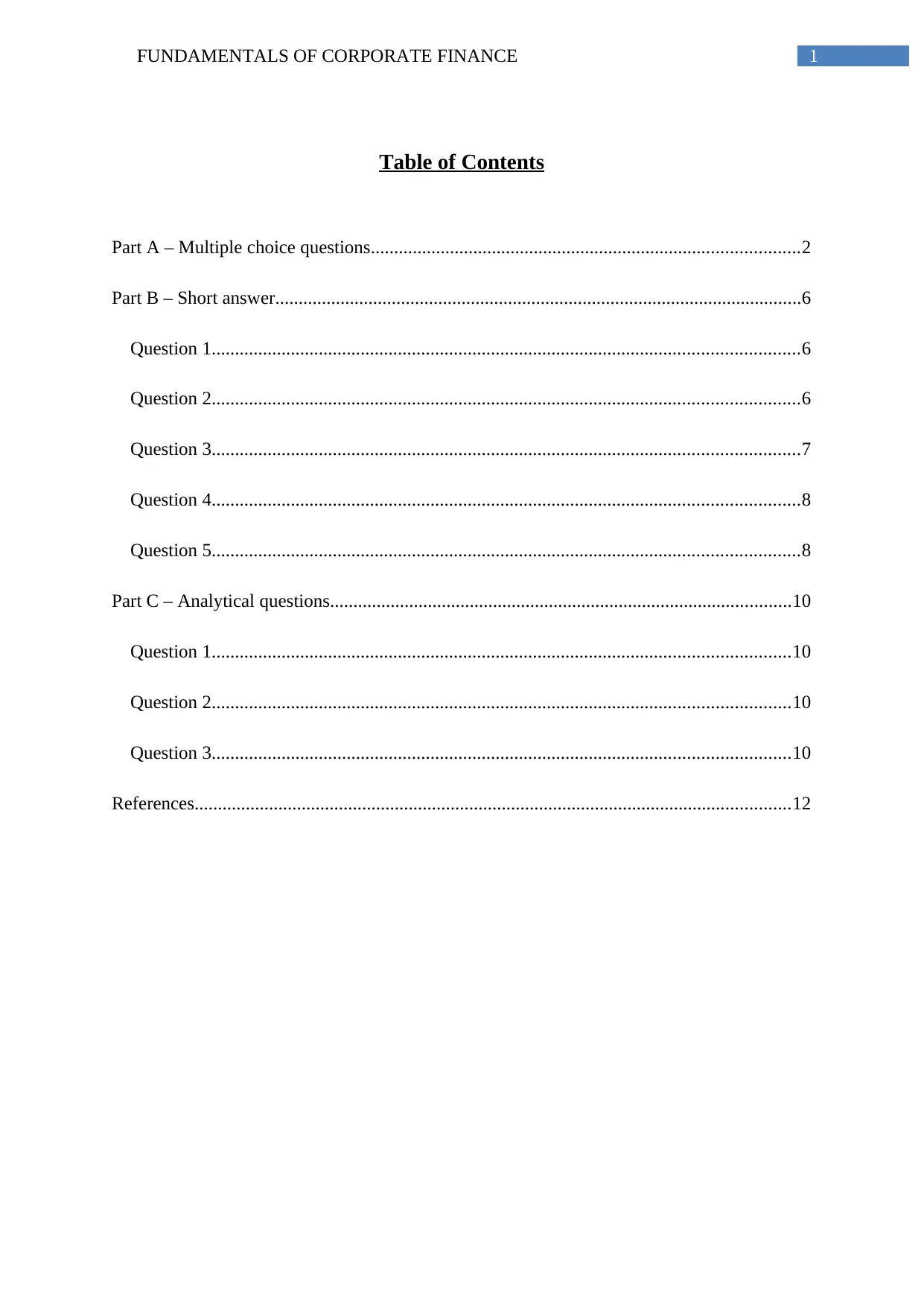
1FUNDAMENTALS OF CORPORATE FINANCE
Table of Contents
Part A – Multiple choice questions............................................................................................2
Part B – Short answer.................................................................................................................6
Question 1..............................................................................................................................6
Question 2..............................................................................................................................6
Question 3..............................................................................................................................7
Question 4..............................................................................................................................8
Question 5..............................................................................................................................8
Part C – Analytical questions...................................................................................................10
Question 1............................................................................................................................10
Question 2............................................................................................................................10
Question 3............................................................................................................................10
References................................................................................................................................12
Table of Contents
Part A – Multiple choice questions............................................................................................2
Part B – Short answer.................................................................................................................6
Question 1..............................................................................................................................6
Question 2..............................................................................................................................6
Question 3..............................................................................................................................7
Question 4..............................................................................................................................8
Question 5..............................................................................................................................8
Part C – Analytical questions...................................................................................................10
Question 1............................................................................................................................10
Question 2............................................................................................................................10
Question 3............................................................................................................................10
References................................................................................................................................12
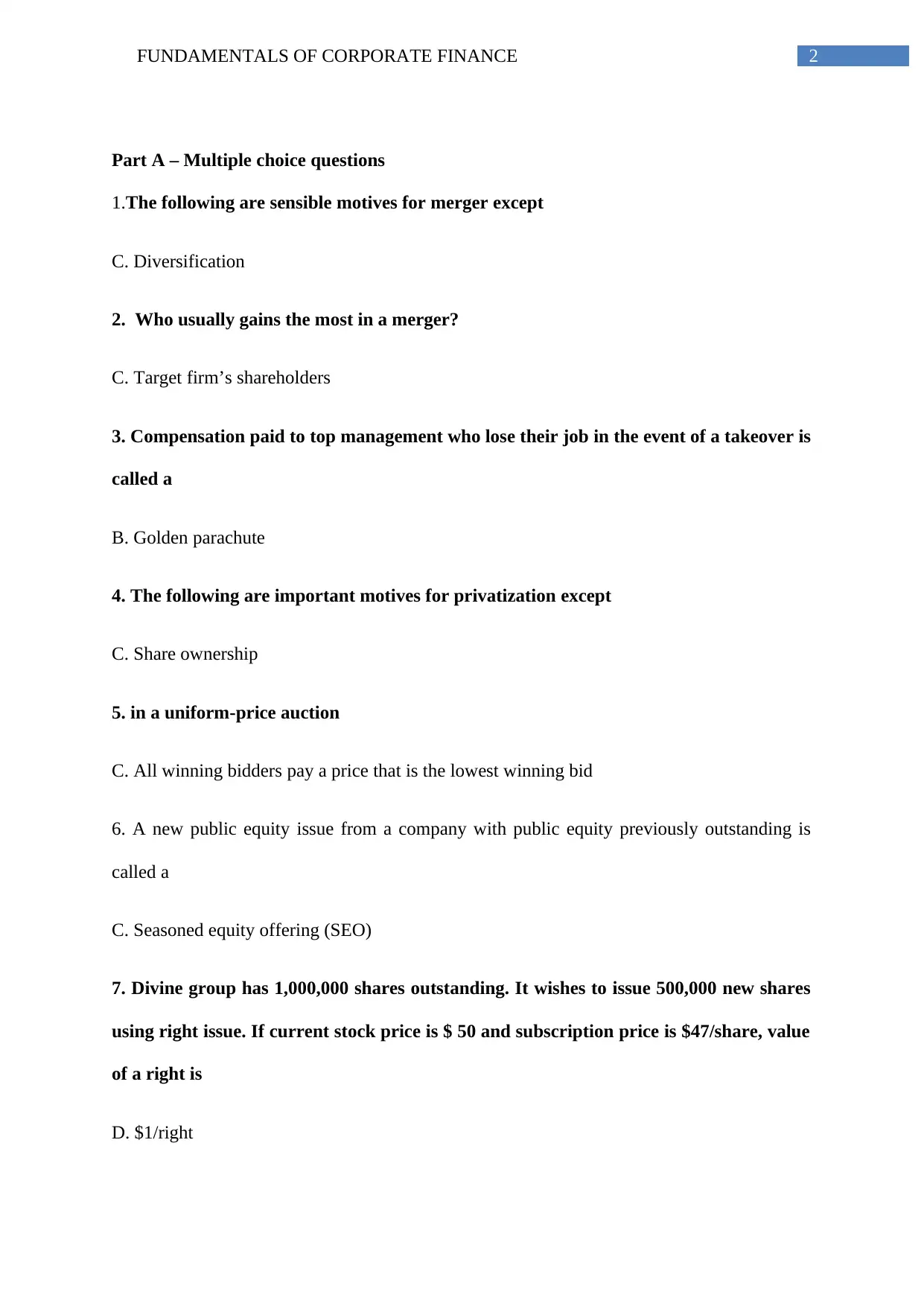
2FUNDAMENTALS OF CORPORATE FINANCE
Part A – Multiple choice questions
1.The following are sensible motives for merger except
C. Diversification
2. Who usually gains the most in a merger?
C. Target firm’s shareholders
3. Compensation paid to top management who lose their job in the event of a takeover is
called a
B. Golden parachute
4. The following are important motives for privatization except
C. Share ownership
5. in a uniform-price auction
C. All winning bidders pay a price that is the lowest winning bid
6. A new public equity issue from a company with public equity previously outstanding is
called a
C. Seasoned equity offering (SEO)
7. Divine group has 1,000,000 shares outstanding. It wishes to issue 500,000 new shares
using right issue. If current stock price is $ 50 and subscription price is $47/share, value
of a right is
D. $1/right
Part A – Multiple choice questions
1.The following are sensible motives for merger except
C. Diversification
2. Who usually gains the most in a merger?
C. Target firm’s shareholders
3. Compensation paid to top management who lose their job in the event of a takeover is
called a
B. Golden parachute
4. The following are important motives for privatization except
C. Share ownership
5. in a uniform-price auction
C. All winning bidders pay a price that is the lowest winning bid
6. A new public equity issue from a company with public equity previously outstanding is
called a
C. Seasoned equity offering (SEO)
7. Divine group has 1,000,000 shares outstanding. It wishes to issue 500,000 new shares
using right issue. If current stock price is $ 50 and subscription price is $47/share, value
of a right is
D. $1/right
⊘ This is a preview!⊘
Do you want full access?
Subscribe today to unlock all pages.

Trusted by 1+ million students worldwide
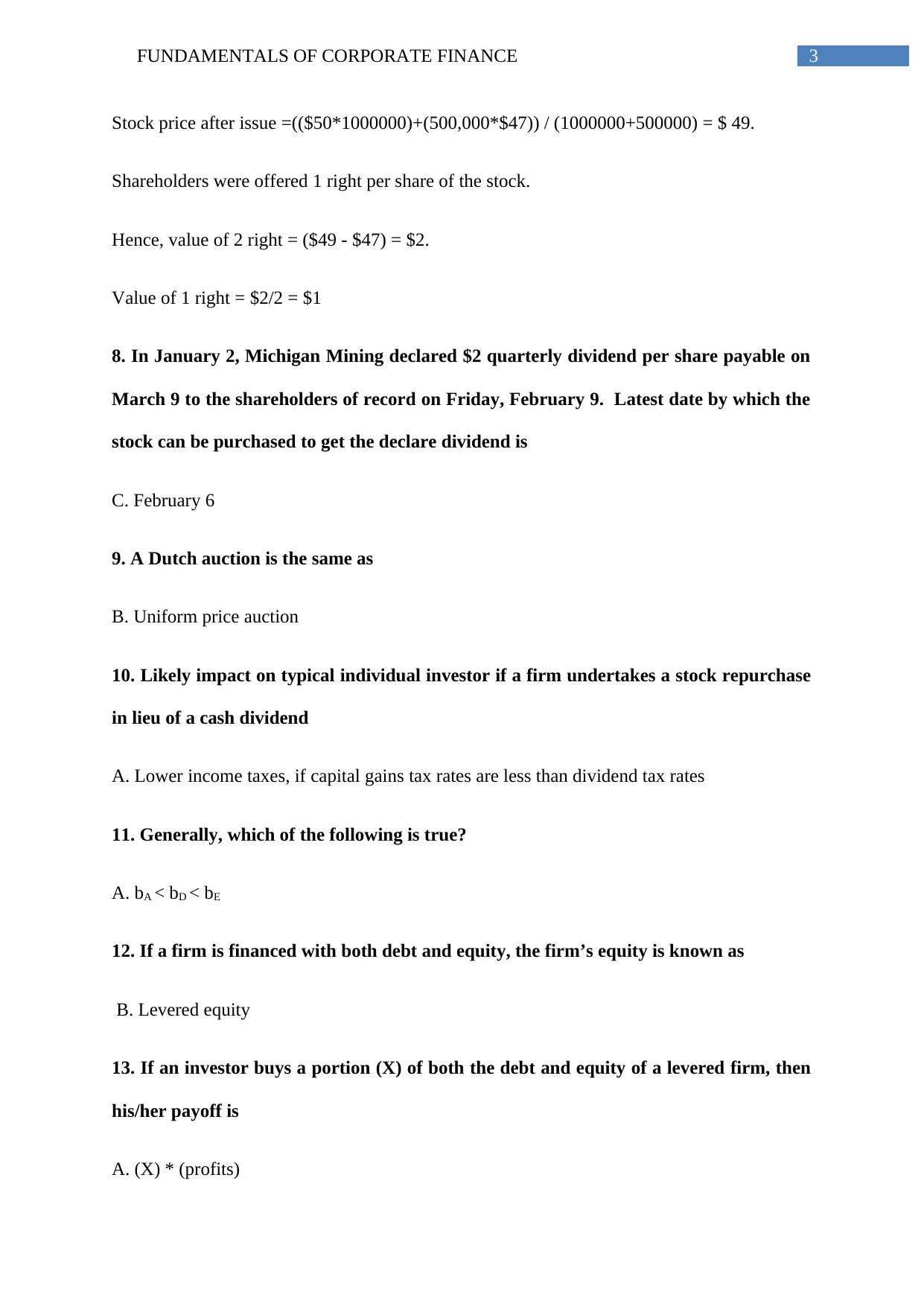
3FUNDAMENTALS OF CORPORATE FINANCE
Stock price after issue =(($50*1000000)+(500,000*$47)) / (1000000+500000) = $ 49.
Shareholders were offered 1 right per share of the stock.
Hence, value of 2 right = ($49 - $47) = $2.
Value of 1 right = $2/2 = $1
8. In January 2, Michigan Mining declared $2 quarterly dividend per share payable on
March 9 to the shareholders of record on Friday, February 9. Latest date by which the
stock can be purchased to get the declare dividend is
C. February 6
9. A Dutch auction is the same as
B. Uniform price auction
10. Likely impact on typical individual investor if a firm undertakes a stock repurchase
in lieu of a cash dividend
A. Lower income taxes, if capital gains tax rates are less than dividend tax rates
11. Generally, which of the following is true?
A. bA < bD < bE
12. If a firm is financed with both debt and equity, the firm’s equity is known as
B. Levered equity
13. If an investor buys a portion (X) of both the debt and equity of a levered firm, then
his/her payoff is
A. (X) * (profits)
Stock price after issue =(($50*1000000)+(500,000*$47)) / (1000000+500000) = $ 49.
Shareholders were offered 1 right per share of the stock.
Hence, value of 2 right = ($49 - $47) = $2.
Value of 1 right = $2/2 = $1
8. In January 2, Michigan Mining declared $2 quarterly dividend per share payable on
March 9 to the shareholders of record on Friday, February 9. Latest date by which the
stock can be purchased to get the declare dividend is
C. February 6
9. A Dutch auction is the same as
B. Uniform price auction
10. Likely impact on typical individual investor if a firm undertakes a stock repurchase
in lieu of a cash dividend
A. Lower income taxes, if capital gains tax rates are less than dividend tax rates
11. Generally, which of the following is true?
A. bA < bD < bE
12. If a firm is financed with both debt and equity, the firm’s equity is known as
B. Levered equity
13. If an investor buys a portion (X) of both the debt and equity of a levered firm, then
his/her payoff is
A. (X) * (profits)
Paraphrase This Document
Need a fresh take? Get an instant paraphrase of this document with our AI Paraphraser
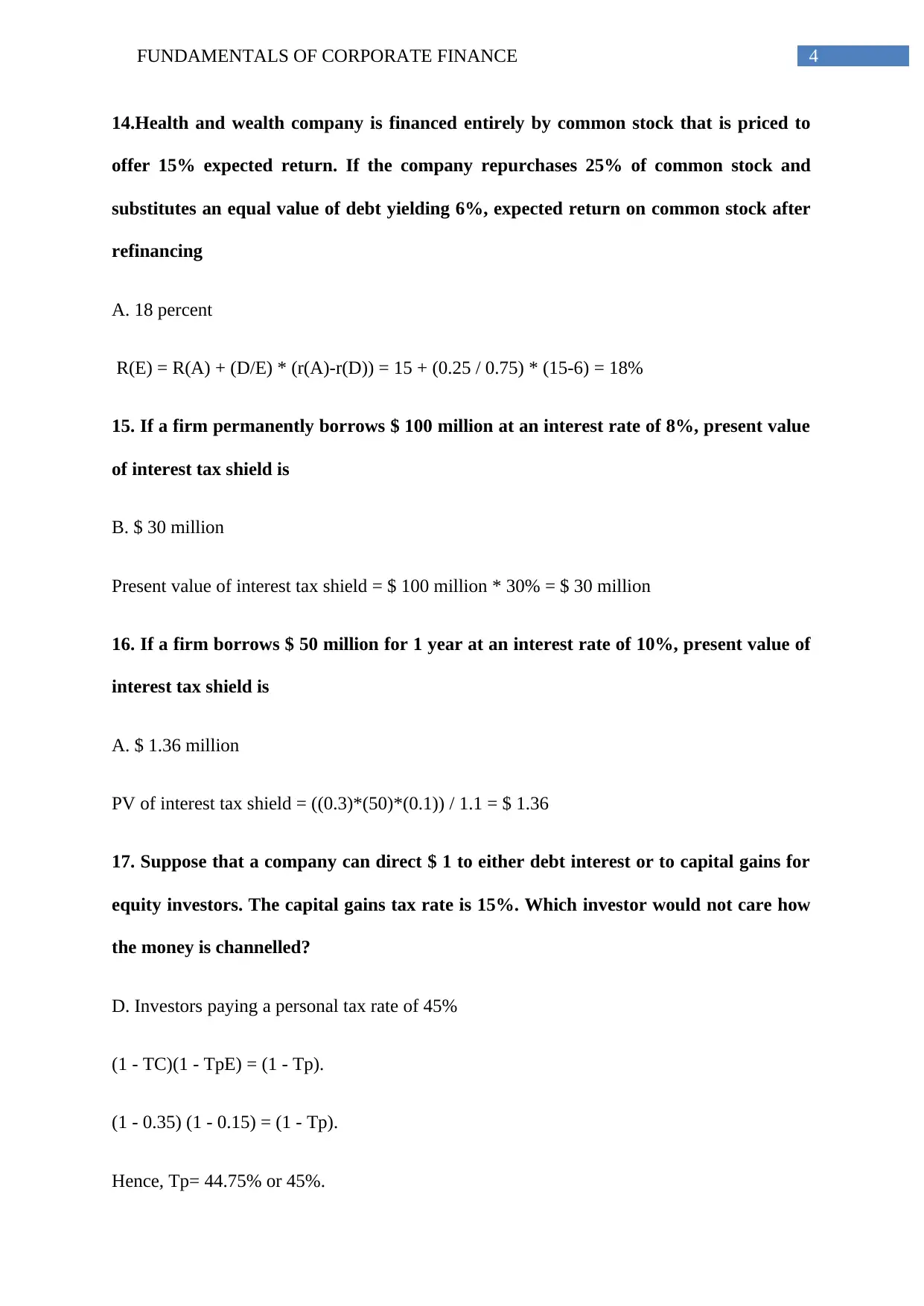
4FUNDAMENTALS OF CORPORATE FINANCE
14.Health and wealth company is financed entirely by common stock that is priced to
offer 15% expected return. If the company repurchases 25% of common stock and
substitutes an equal value of debt yielding 6%, expected return on common stock after
refinancing
A. 18 percent
R(E) = R(A) + (D/E) * (r(A)-r(D)) = 15 + (0.25 / 0.75) * (15-6) = 18%
15. If a firm permanently borrows $ 100 million at an interest rate of 8%, present value
of interest tax shield is
B. $ 30 million
Present value of interest tax shield = $ 100 million * 30% = $ 30 million
16. If a firm borrows $ 50 million for 1 year at an interest rate of 10%, present value of
interest tax shield is
A. $ 1.36 million
PV of interest tax shield = ((0.3)*(50)*(0.1)) / 1.1 = $ 1.36
17. Suppose that a company can direct $ 1 to either debt interest or to capital gains for
equity investors. The capital gains tax rate is 15%. Which investor would not care how
the money is channelled?
D. Investors paying a personal tax rate of 45%
(1 - TC)(1 - TpE) = (1 - Tp).
(1 - 0.35) (1 - 0.15) = (1 - Tp).
Hence, Tp= 44.75% or 45%.
14.Health and wealth company is financed entirely by common stock that is priced to
offer 15% expected return. If the company repurchases 25% of common stock and
substitutes an equal value of debt yielding 6%, expected return on common stock after
refinancing
A. 18 percent
R(E) = R(A) + (D/E) * (r(A)-r(D)) = 15 + (0.25 / 0.75) * (15-6) = 18%
15. If a firm permanently borrows $ 100 million at an interest rate of 8%, present value
of interest tax shield is
B. $ 30 million
Present value of interest tax shield = $ 100 million * 30% = $ 30 million
16. If a firm borrows $ 50 million for 1 year at an interest rate of 10%, present value of
interest tax shield is
A. $ 1.36 million
PV of interest tax shield = ((0.3)*(50)*(0.1)) / 1.1 = $ 1.36
17. Suppose that a company can direct $ 1 to either debt interest or to capital gains for
equity investors. The capital gains tax rate is 15%. Which investor would not care how
the money is channelled?
D. Investors paying a personal tax rate of 45%
(1 - TC)(1 - TpE) = (1 - Tp).
(1 - 0.35) (1 - 0.15) = (1 - Tp).
Hence, Tp= 44.75% or 45%.
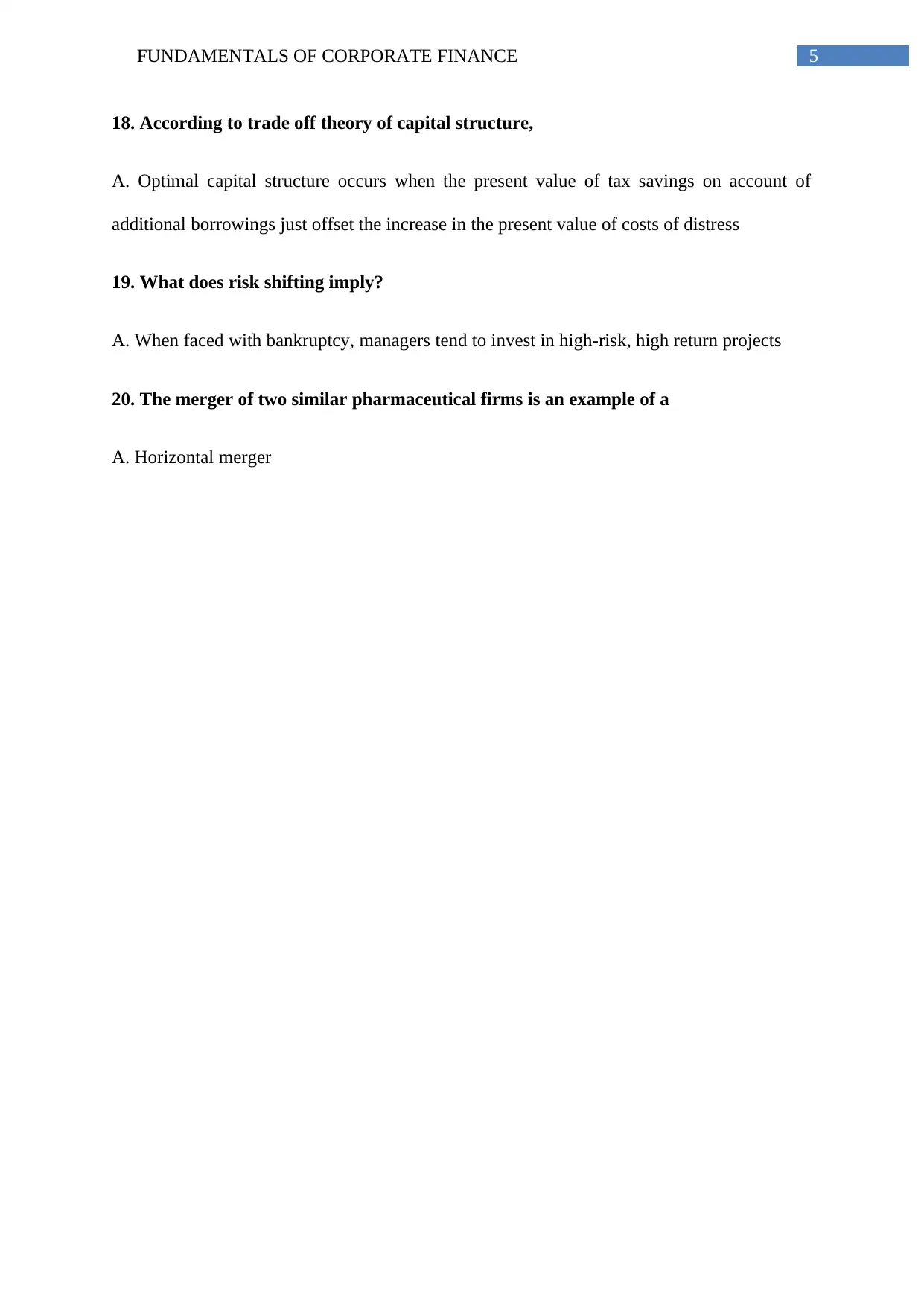
5FUNDAMENTALS OF CORPORATE FINANCE
18. According to trade off theory of capital structure,
A. Optimal capital structure occurs when the present value of tax savings on account of
additional borrowings just offset the increase in the present value of costs of distress
19. What does risk shifting imply?
A. When faced with bankruptcy, managers tend to invest in high-risk, high return projects
20. The merger of two similar pharmaceutical firms is an example of a
A. Horizontal merger
18. According to trade off theory of capital structure,
A. Optimal capital structure occurs when the present value of tax savings on account of
additional borrowings just offset the increase in the present value of costs of distress
19. What does risk shifting imply?
A. When faced with bankruptcy, managers tend to invest in high-risk, high return projects
20. The merger of two similar pharmaceutical firms is an example of a
A. Horizontal merger
⊘ This is a preview!⊘
Do you want full access?
Subscribe today to unlock all pages.

Trusted by 1+ million students worldwide
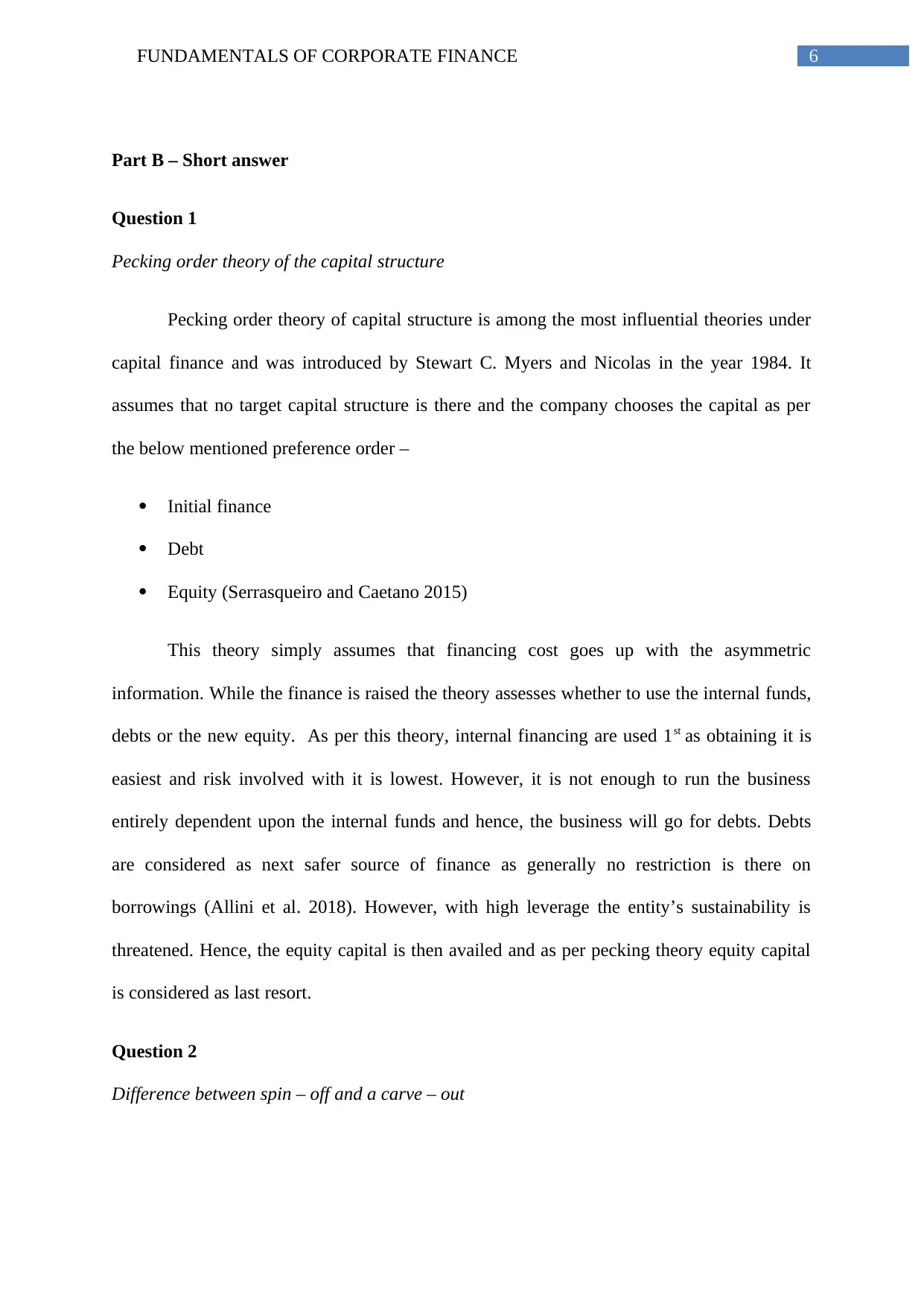
6FUNDAMENTALS OF CORPORATE FINANCE
Part B – Short answer
Question 1
Pecking order theory of the capital structure
Pecking order theory of capital structure is among the most influential theories under
capital finance and was introduced by Stewart C. Myers and Nicolas in the year 1984. It
assumes that no target capital structure is there and the company chooses the capital as per
the below mentioned preference order –
Initial finance
Debt
Equity (Serrasqueiro and Caetano 2015)
This theory simply assumes that financing cost goes up with the asymmetric
information. While the finance is raised the theory assesses whether to use the internal funds,
debts or the new equity. As per this theory, internal financing are used 1st as obtaining it is
easiest and risk involved with it is lowest. However, it is not enough to run the business
entirely dependent upon the internal funds and hence, the business will go for debts. Debts
are considered as next safer source of finance as generally no restriction is there on
borrowings (Allini et al. 2018). However, with high leverage the entity’s sustainability is
threatened. Hence, the equity capital is then availed and as per pecking theory equity capital
is considered as last resort.
Question 2
Difference between spin – off and a carve – out
Part B – Short answer
Question 1
Pecking order theory of the capital structure
Pecking order theory of capital structure is among the most influential theories under
capital finance and was introduced by Stewart C. Myers and Nicolas in the year 1984. It
assumes that no target capital structure is there and the company chooses the capital as per
the below mentioned preference order –
Initial finance
Debt
Equity (Serrasqueiro and Caetano 2015)
This theory simply assumes that financing cost goes up with the asymmetric
information. While the finance is raised the theory assesses whether to use the internal funds,
debts or the new equity. As per this theory, internal financing are used 1st as obtaining it is
easiest and risk involved with it is lowest. However, it is not enough to run the business
entirely dependent upon the internal funds and hence, the business will go for debts. Debts
are considered as next safer source of finance as generally no restriction is there on
borrowings (Allini et al. 2018). However, with high leverage the entity’s sustainability is
threatened. Hence, the equity capital is then availed and as per pecking theory equity capital
is considered as last resort.
Question 2
Difference between spin – off and a carve – out
Paraphrase This Document
Need a fresh take? Get an instant paraphrase of this document with our AI Paraphraser
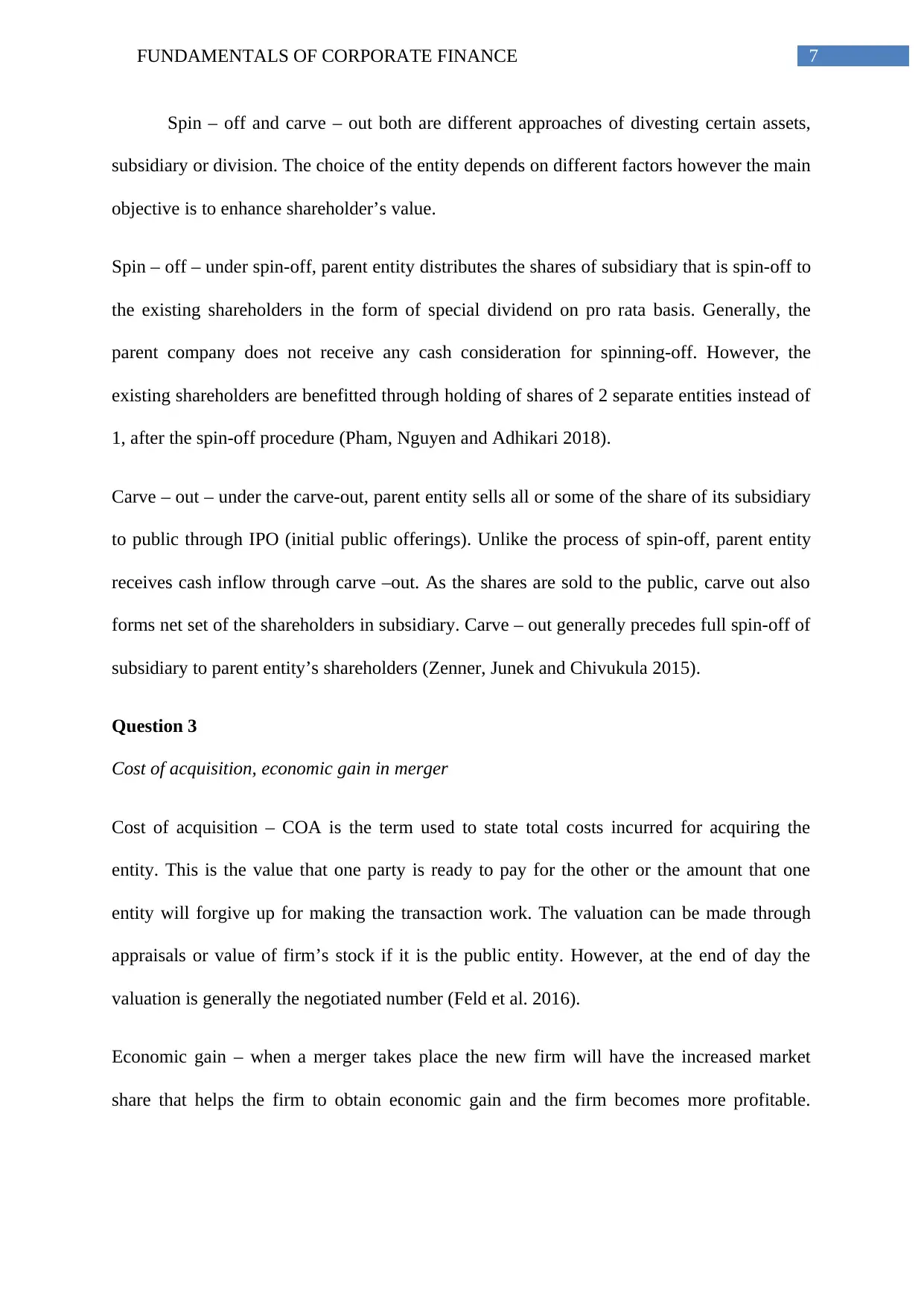
7FUNDAMENTALS OF CORPORATE FINANCE
Spin – off and carve – out both are different approaches of divesting certain assets,
subsidiary or division. The choice of the entity depends on different factors however the main
objective is to enhance shareholder’s value.
Spin – off – under spin-off, parent entity distributes the shares of subsidiary that is spin-off to
the existing shareholders in the form of special dividend on pro rata basis. Generally, the
parent company does not receive any cash consideration for spinning-off. However, the
existing shareholders are benefitted through holding of shares of 2 separate entities instead of
1, after the spin-off procedure (Pham, Nguyen and Adhikari 2018).
Carve – out – under the carve-out, parent entity sells all or some of the share of its subsidiary
to public through IPO (initial public offerings). Unlike the process of spin-off, parent entity
receives cash inflow through carve –out. As the shares are sold to the public, carve out also
forms net set of the shareholders in subsidiary. Carve – out generally precedes full spin-off of
subsidiary to parent entity’s shareholders (Zenner, Junek and Chivukula 2015).
Question 3
Cost of acquisition, economic gain in merger
Cost of acquisition – COA is the term used to state total costs incurred for acquiring the
entity. This is the value that one party is ready to pay for the other or the amount that one
entity will forgive up for making the transaction work. The valuation can be made through
appraisals or value of firm’s stock if it is the public entity. However, at the end of day the
valuation is generally the negotiated number (Feld et al. 2016).
Economic gain – when a merger takes place the new firm will have the increased market
share that helps the firm to obtain economic gain and the firm becomes more profitable.
Spin – off and carve – out both are different approaches of divesting certain assets,
subsidiary or division. The choice of the entity depends on different factors however the main
objective is to enhance shareholder’s value.
Spin – off – under spin-off, parent entity distributes the shares of subsidiary that is spin-off to
the existing shareholders in the form of special dividend on pro rata basis. Generally, the
parent company does not receive any cash consideration for spinning-off. However, the
existing shareholders are benefitted through holding of shares of 2 separate entities instead of
1, after the spin-off procedure (Pham, Nguyen and Adhikari 2018).
Carve – out – under the carve-out, parent entity sells all or some of the share of its subsidiary
to public through IPO (initial public offerings). Unlike the process of spin-off, parent entity
receives cash inflow through carve –out. As the shares are sold to the public, carve out also
forms net set of the shareholders in subsidiary. Carve – out generally precedes full spin-off of
subsidiary to parent entity’s shareholders (Zenner, Junek and Chivukula 2015).
Question 3
Cost of acquisition, economic gain in merger
Cost of acquisition – COA is the term used to state total costs incurred for acquiring the
entity. This is the value that one party is ready to pay for the other or the amount that one
entity will forgive up for making the transaction work. The valuation can be made through
appraisals or value of firm’s stock if it is the public entity. However, at the end of day the
valuation is generally the negotiated number (Feld et al. 2016).
Economic gain – when a merger takes place the new firm will have the increased market
share that helps the firm to obtain economic gain and the firm becomes more profitable.
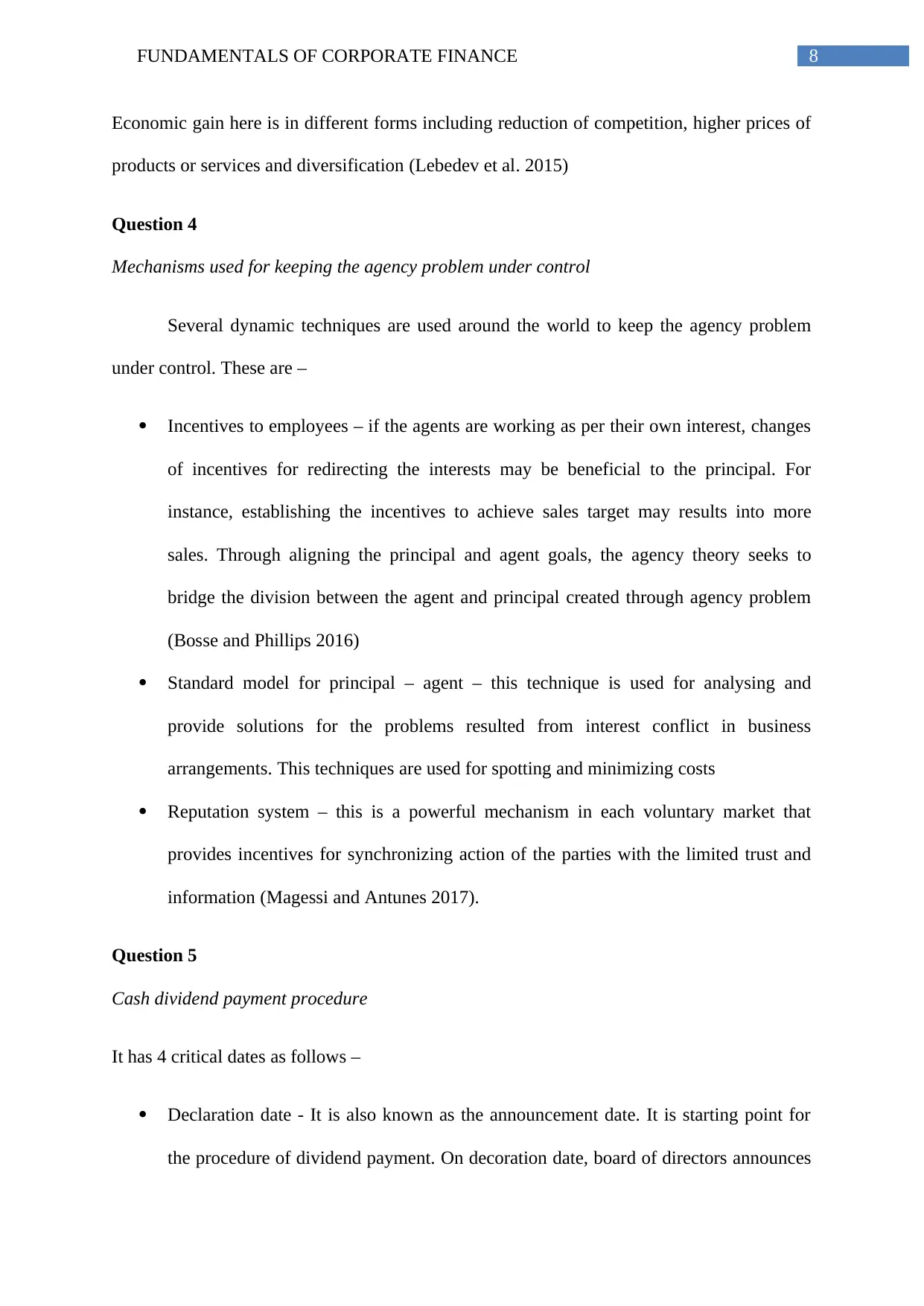
8FUNDAMENTALS OF CORPORATE FINANCE
Economic gain here is in different forms including reduction of competition, higher prices of
products or services and diversification (Lebedev et al. 2015)
Question 4
Mechanisms used for keeping the agency problem under control
Several dynamic techniques are used around the world to keep the agency problem
under control. These are –
Incentives to employees – if the agents are working as per their own interest, changes
of incentives for redirecting the interests may be beneficial to the principal. For
instance, establishing the incentives to achieve sales target may results into more
sales. Through aligning the principal and agent goals, the agency theory seeks to
bridge the division between the agent and principal created through agency problem
(Bosse and Phillips 2016)
Standard model for principal – agent – this technique is used for analysing and
provide solutions for the problems resulted from interest conflict in business
arrangements. This techniques are used for spotting and minimizing costs
Reputation system – this is a powerful mechanism in each voluntary market that
provides incentives for synchronizing action of the parties with the limited trust and
information (Magessi and Antunes 2017).
Question 5
Cash dividend payment procedure
It has 4 critical dates as follows –
Declaration date - It is also known as the announcement date. It is starting point for
the procedure of dividend payment. On decoration date, board of directors announces
Economic gain here is in different forms including reduction of competition, higher prices of
products or services and diversification (Lebedev et al. 2015)
Question 4
Mechanisms used for keeping the agency problem under control
Several dynamic techniques are used around the world to keep the agency problem
under control. These are –
Incentives to employees – if the agents are working as per their own interest, changes
of incentives for redirecting the interests may be beneficial to the principal. For
instance, establishing the incentives to achieve sales target may results into more
sales. Through aligning the principal and agent goals, the agency theory seeks to
bridge the division between the agent and principal created through agency problem
(Bosse and Phillips 2016)
Standard model for principal – agent – this technique is used for analysing and
provide solutions for the problems resulted from interest conflict in business
arrangements. This techniques are used for spotting and minimizing costs
Reputation system – this is a powerful mechanism in each voluntary market that
provides incentives for synchronizing action of the parties with the limited trust and
information (Magessi and Antunes 2017).
Question 5
Cash dividend payment procedure
It has 4 critical dates as follows –
Declaration date - It is also known as the announcement date. It is starting point for
the procedure of dividend payment. On decoration date, board of directors announces
⊘ This is a preview!⊘
Do you want full access?
Subscribe today to unlock all pages.

Trusted by 1+ million students worldwide
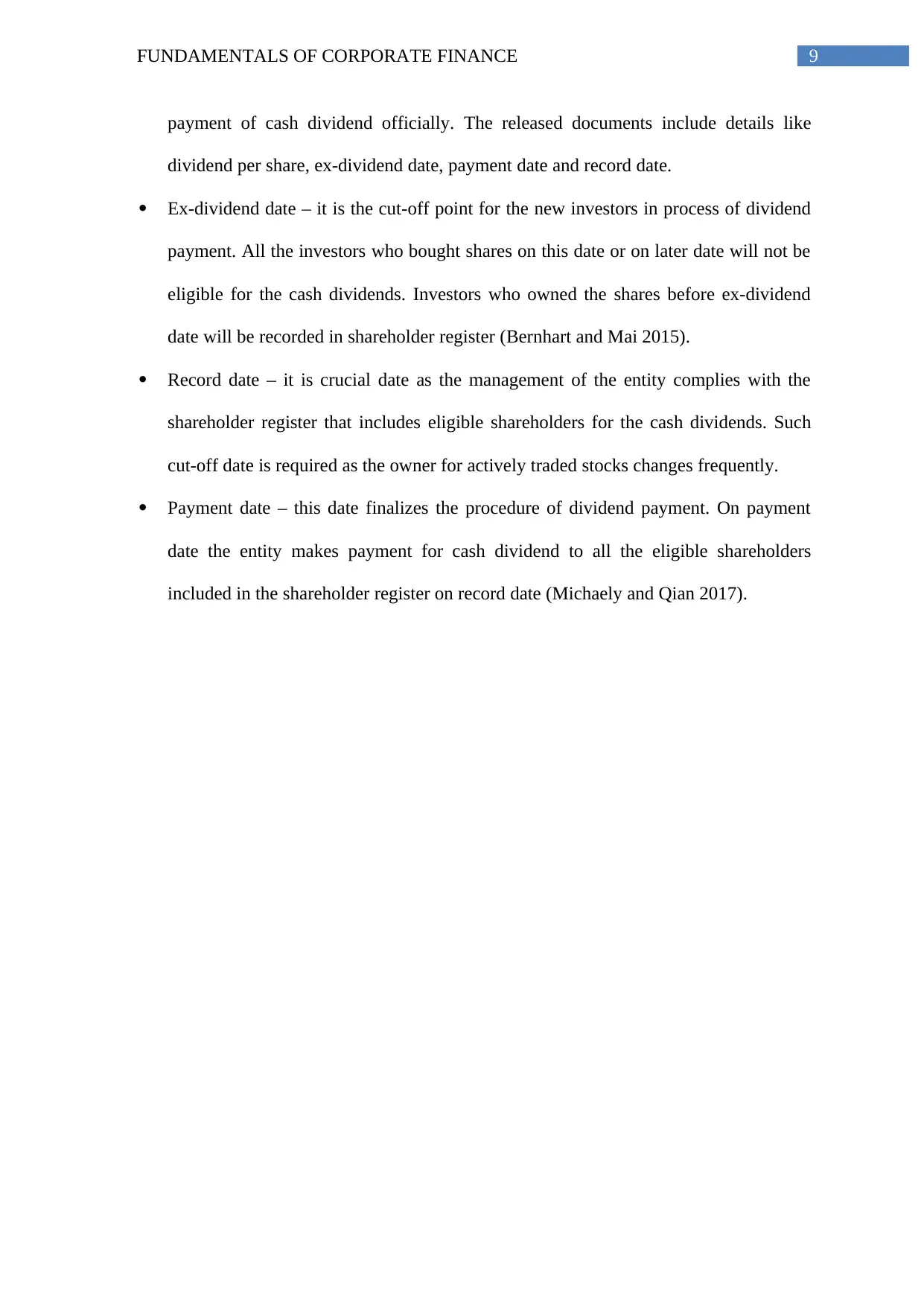
9FUNDAMENTALS OF CORPORATE FINANCE
payment of cash dividend officially. The released documents include details like
dividend per share, ex-dividend date, payment date and record date.
Ex-dividend date – it is the cut-off point for the new investors in process of dividend
payment. All the investors who bought shares on this date or on later date will not be
eligible for the cash dividends. Investors who owned the shares before ex-dividend
date will be recorded in shareholder register (Bernhart and Mai 2015).
Record date – it is crucial date as the management of the entity complies with the
shareholder register that includes eligible shareholders for the cash dividends. Such
cut-off date is required as the owner for actively traded stocks changes frequently.
Payment date – this date finalizes the procedure of dividend payment. On payment
date the entity makes payment for cash dividend to all the eligible shareholders
included in the shareholder register on record date (Michaely and Qian 2017).
payment of cash dividend officially. The released documents include details like
dividend per share, ex-dividend date, payment date and record date.
Ex-dividend date – it is the cut-off point for the new investors in process of dividend
payment. All the investors who bought shares on this date or on later date will not be
eligible for the cash dividends. Investors who owned the shares before ex-dividend
date will be recorded in shareholder register (Bernhart and Mai 2015).
Record date – it is crucial date as the management of the entity complies with the
shareholder register that includes eligible shareholders for the cash dividends. Such
cut-off date is required as the owner for actively traded stocks changes frequently.
Payment date – this date finalizes the procedure of dividend payment. On payment
date the entity makes payment for cash dividend to all the eligible shareholders
included in the shareholder register on record date (Michaely and Qian 2017).
Paraphrase This Document
Need a fresh take? Get an instant paraphrase of this document with our AI Paraphraser
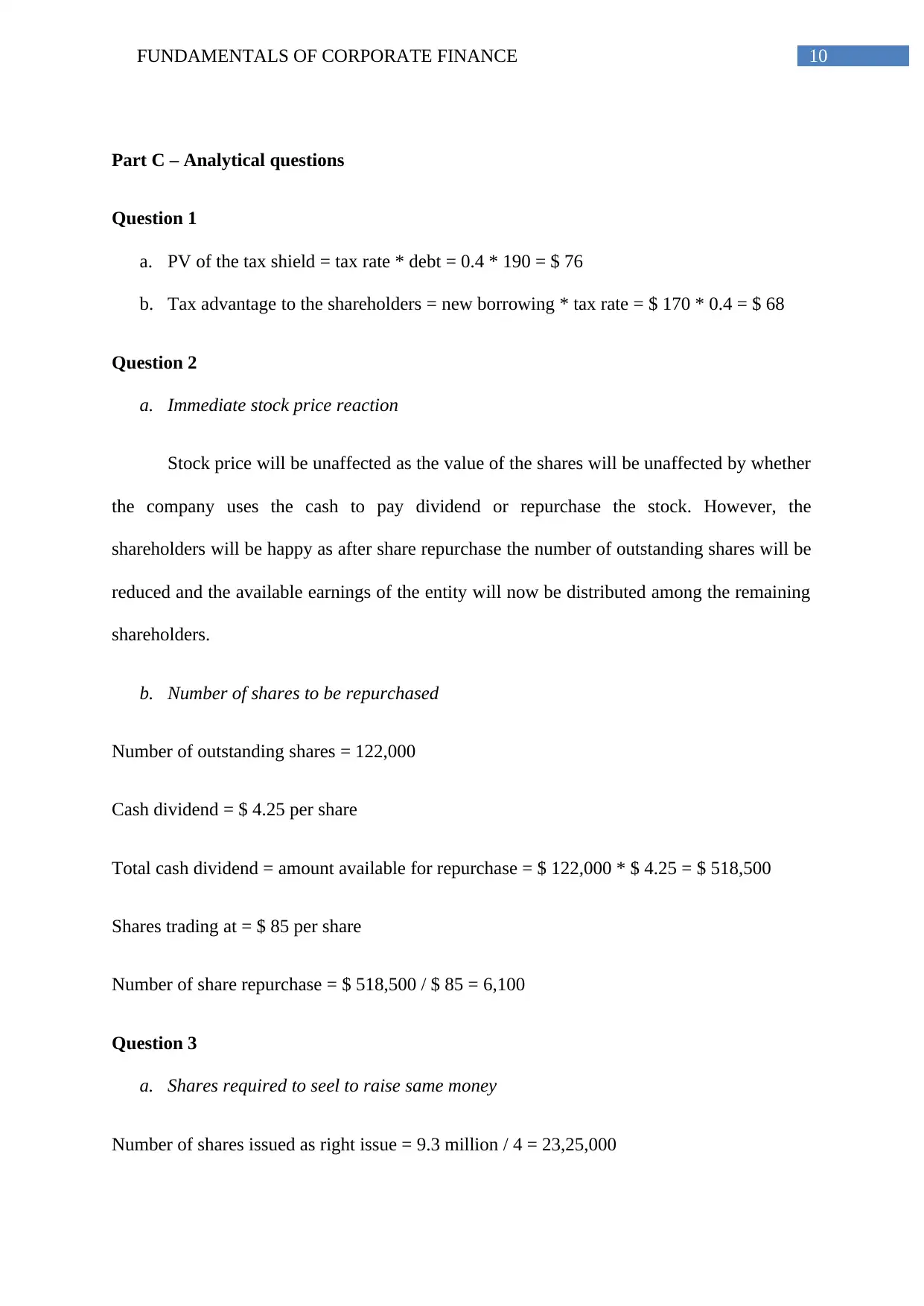
10FUNDAMENTALS OF CORPORATE FINANCE
Part C – Analytical questions
Question 1
a. PV of the tax shield = tax rate * debt = 0.4 * 190 = $ 76
b. Tax advantage to the shareholders = new borrowing * tax rate = $ 170 * 0.4 = $ 68
Question 2
a. Immediate stock price reaction
Stock price will be unaffected as the value of the shares will be unaffected by whether
the company uses the cash to pay dividend or repurchase the stock. However, the
shareholders will be happy as after share repurchase the number of outstanding shares will be
reduced and the available earnings of the entity will now be distributed among the remaining
shareholders.
b. Number of shares to be repurchased
Number of outstanding shares = 122,000
Cash dividend = $ 4.25 per share
Total cash dividend = amount available for repurchase = $ 122,000 * $ 4.25 = $ 518,500
Shares trading at = $ 85 per share
Number of share repurchase = $ 518,500 / $ 85 = 6,100
Question 3
a. Shares required to seel to raise same money
Number of shares issued as right issue = 9.3 million / 4 = 23,25,000
Part C – Analytical questions
Question 1
a. PV of the tax shield = tax rate * debt = 0.4 * 190 = $ 76
b. Tax advantage to the shareholders = new borrowing * tax rate = $ 170 * 0.4 = $ 68
Question 2
a. Immediate stock price reaction
Stock price will be unaffected as the value of the shares will be unaffected by whether
the company uses the cash to pay dividend or repurchase the stock. However, the
shareholders will be happy as after share repurchase the number of outstanding shares will be
reduced and the available earnings of the entity will now be distributed among the remaining
shareholders.
b. Number of shares to be repurchased
Number of outstanding shares = 122,000
Cash dividend = $ 4.25 per share
Total cash dividend = amount available for repurchase = $ 122,000 * $ 4.25 = $ 518,500
Shares trading at = $ 85 per share
Number of share repurchase = $ 518,500 / $ 85 = 6,100
Question 3
a. Shares required to seel to raise same money
Number of shares issued as right issue = 9.3 million / 4 = 23,25,000
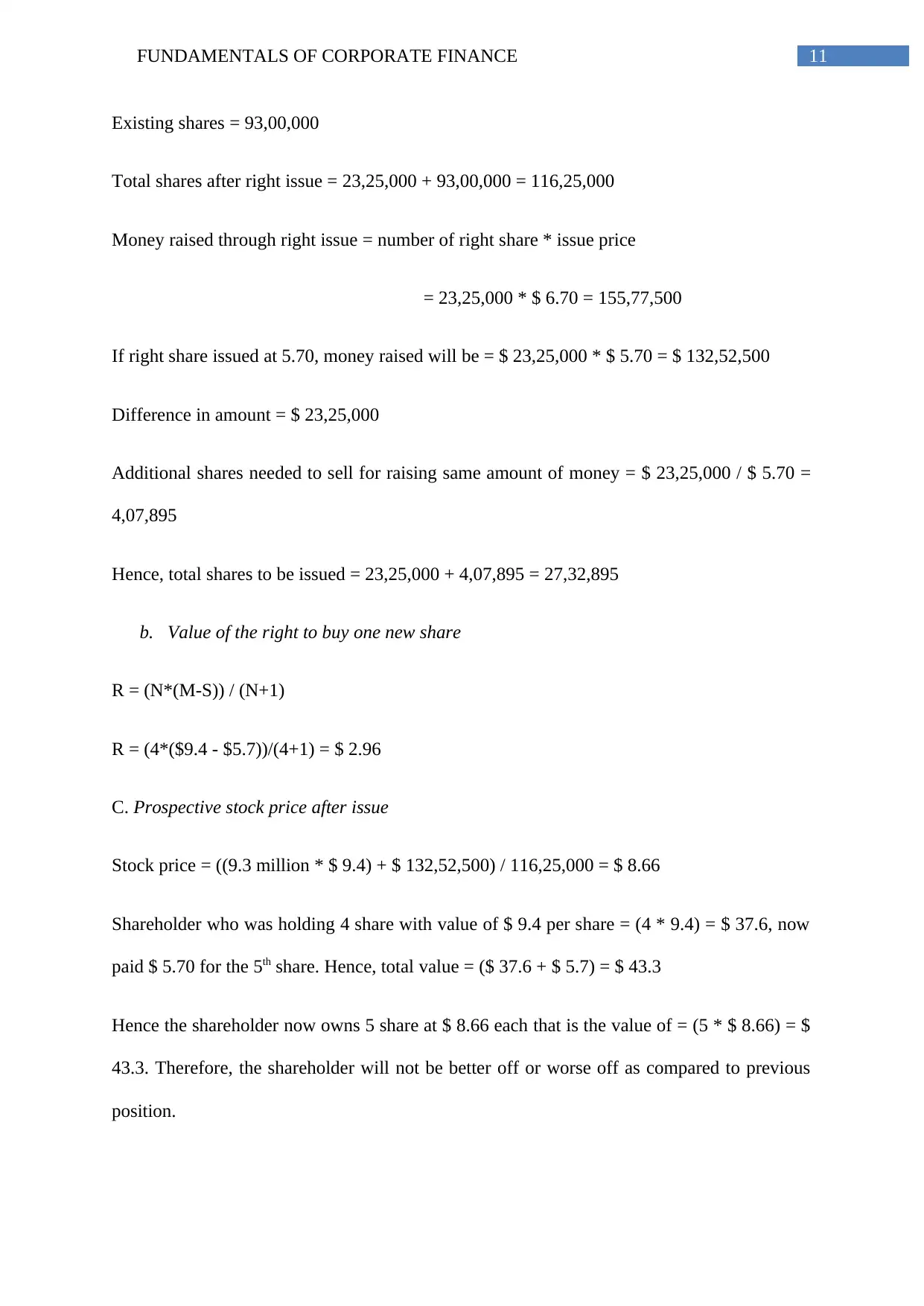
11FUNDAMENTALS OF CORPORATE FINANCE
Existing shares = 93,00,000
Total shares after right issue = 23,25,000 + 93,00,000 = 116,25,000
Money raised through right issue = number of right share * issue price
= 23,25,000 * $ 6.70 = 155,77,500
If right share issued at 5.70, money raised will be = $ 23,25,000 * $ 5.70 = $ 132,52,500
Difference in amount = $ 23,25,000
Additional shares needed to sell for raising same amount of money = $ 23,25,000 / $ 5.70 =
4,07,895
Hence, total shares to be issued = 23,25,000 + 4,07,895 = 27,32,895
b. Value of the right to buy one new share
R = (N*(M-S)) / (N+1)
R = (4*($9.4 - $5.7))/(4+1) = $ 2.96
C. Prospective stock price after issue
Stock price = ((9.3 million * $ 9.4) + $ 132,52,500) / 116,25,000 = $ 8.66
Shareholder who was holding 4 share with value of $ 9.4 per share = (4 * 9.4) = $ 37.6, now
paid $ 5.70 for the 5th share. Hence, total value = ($ 37.6 + $ 5.7) = $ 43.3
Hence the shareholder now owns 5 share at $ 8.66 each that is the value of = (5 * $ 8.66) = $
43.3. Therefore, the shareholder will not be better off or worse off as compared to previous
position.
Existing shares = 93,00,000
Total shares after right issue = 23,25,000 + 93,00,000 = 116,25,000
Money raised through right issue = number of right share * issue price
= 23,25,000 * $ 6.70 = 155,77,500
If right share issued at 5.70, money raised will be = $ 23,25,000 * $ 5.70 = $ 132,52,500
Difference in amount = $ 23,25,000
Additional shares needed to sell for raising same amount of money = $ 23,25,000 / $ 5.70 =
4,07,895
Hence, total shares to be issued = 23,25,000 + 4,07,895 = 27,32,895
b. Value of the right to buy one new share
R = (N*(M-S)) / (N+1)
R = (4*($9.4 - $5.7))/(4+1) = $ 2.96
C. Prospective stock price after issue
Stock price = ((9.3 million * $ 9.4) + $ 132,52,500) / 116,25,000 = $ 8.66
Shareholder who was holding 4 share with value of $ 9.4 per share = (4 * 9.4) = $ 37.6, now
paid $ 5.70 for the 5th share. Hence, total value = ($ 37.6 + $ 5.7) = $ 43.3
Hence the shareholder now owns 5 share at $ 8.66 each that is the value of = (5 * $ 8.66) = $
43.3. Therefore, the shareholder will not be better off or worse off as compared to previous
position.
⊘ This is a preview!⊘
Do you want full access?
Subscribe today to unlock all pages.

Trusted by 1+ million students worldwide
1 out of 14
Related Documents
Your All-in-One AI-Powered Toolkit for Academic Success.
+13062052269
info@desklib.com
Available 24*7 on WhatsApp / Email
![[object Object]](/_next/static/media/star-bottom.7253800d.svg)
Unlock your academic potential
Copyright © 2020–2025 A2Z Services. All Rights Reserved. Developed and managed by ZUCOL.





